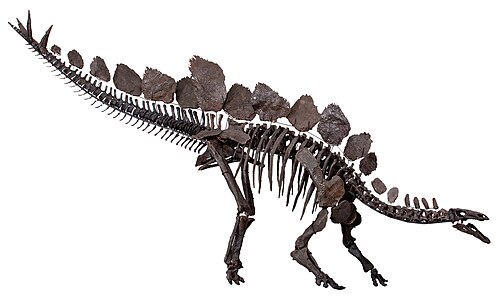Facts for Kids
Stegosaurus is a distinctive dinosaur known for its plated back and spiked tail, living during the late Jurassic period as a large herbivore.
Overview
Habitat And Range
Physical Characteristics
Diet And Feeding Behavior
Social Behavior And Reproduction
Fossil Discovery And Paleontology
Cultural Impact And Representation
Conservation And Scientific Importance
Related Species And Evolutionary History

Inside this Article
Huayangosaurus
Information
Allosaurus
Jurassic
Dinosaur
Culture
Climate
Season
Marsh
Did you know?
🦕 The Stegosaurus lived during the late Jurassic period, around 155 to 150 million years ago.
🦷 It was known for its distinctive double row of large bony plates along its back.
🌍 Stegosaurus fossils have been found mainly in North America and Europe.
🍃 Stegosaurus was a herbivore, primarily feeding on low-lying ferns and other vegetation.
📏 It could grow up to 30 feet long and weigh between 5 to 7 tons.
🧠 Despite its size, the Stegosaurus had a relatively small brain, about the size of a walnut.
🔒 Its tail had sharp spikes known as the thagomizer, which were likely used for defense.
👣 Scientists believe it walked on all fours, with its front legs shorter than its hind legs.
💧 Stegosaurus lived in a warm, humid environment rich in plant life.
🥉 It is one of the most recognizable dinosaurs due to its unique body shape and features.
Introduction
This dinosaur was famous for its large, bony plates along its back and its spiky tail, called a thagomizer. Stegosaurus was about the size of a bus, growing up to 30 feet long! This dinosaur was discovered in the late 1800s by a paleontologist named Othniel Charles Marsh. Stegosaurus roamed the forests of what is now North America, particularly in states like Colorado and Utah. It walked on four legs and had a small head compared to its huge body! 🌳
Habitat And Range
These dinosaurs thrived in what we now call North America, particularly in areas that had plenty of large ferns, cycads, and other prehistoric plants. They preferred river valleys and floodplains where food was abundant. Fossils have been found in places like Morrison Formation in Colorado, which gives us clues about their life and surroundings millions of years ago. The climate back then was mostly humid and warm, perfect for supporting a variety of plant life! ☀
️
Physical Characteristics
Diet And Feeding Behavior
Its diet included leaves, ferns, and shrubs, and it used its flat teeth to munch on vegetation. Unlike some dinosaurs, Stegosaurus didn’t chew its food much; instead, it swallowed its meals whole. This dinosaur had a long neck, allowing it to reach higher plants while still being able to graze on lower bushes too. It was likely a slow eater, spending most of the day searching for food and munching on the greenery around it. Grass didn't exist back then, so Stegosaurus enjoyed a different selection of tasty plants! 🐢
Social Behavior And Reproduction
🏼 Scientists think they might have gathered together during mating season or to find food. Female Stegosaurus likely laid eggs, and scientists suspect they might have built nests for their young. Like many dinosaurs, the baby Stegosaurus was small, but it grew quickly! Although we don’t know all the details about their social lives, fossils suggest that they were not as social as some other dinosaurs, preferring to wander on their own! 🥚
Fossil Discovery And Paleontology
These bones caused a big stir among scientists, as they had never seen a dinosaur quite like this before. Since then, many more fossils have been discovered, helping researchers learn about their structure and lifestyle. Fossils give us valuable insights into how Stegosaurus lived, what it looked like, and what conditions were like on Earth millions of years ago. Paleontologists continue to dig and uncover new Stegosaurus remains, bringing the past to life! 🚧
Cultural Impact And Representation
It appears in many children's stories and educational materials because of its unique appearance. You might have seen Stegosaurus in the famous movie "Jurassic Park" or in children's cartoons! The funky plates on its back often make it a favorite among kids and adults alike. It symbolizes the Jurassic period, showing how diverse and exciting dinosaurs were. Because of its distinct look, the Stegosaurus has become an important part of dinosaur culture! 🎨
Conservation And Scientific Importance
It helps scientists learn about the changes in climate, plants, and animals over millions of years. By examining Stegosaurus, paleontologists gather valuable information about how different species evolved and how ecosystems worked long ago. Fossils like those of the Stegosaurus also remind us of the importance of conserving our own environment to protect today's wildlife! Learning from the past can help us make better choices for the future! 🌱
Related Species And Evolutionary History
Other related species include the Huayangosaurus and the Wuerhosaurus, which shared some features with Stegosaurus but lived in different parts of the world. Stegosaurids, the family to which Stegosaurus belongs, evolved over time to become specialized herbivores! Unlike theropods, which were carnivorous, Stegosaurus and its relatives adapted to live a peaceful life, munching on plants. Their evolution teaches us about how dinosaurs adapted to their environments millions of years ago! 🔍

